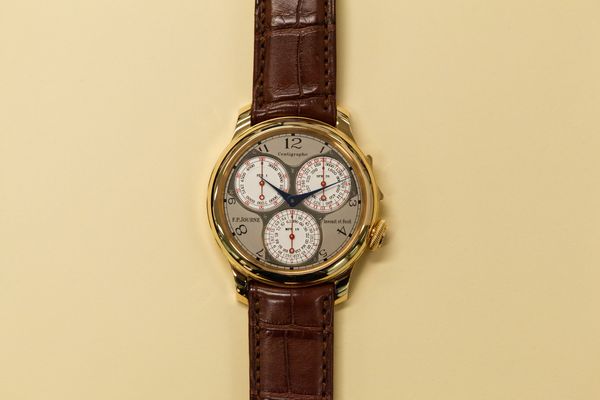Lot 831, F.P. Journe Centigraphe Souverain. A fine and attractive pink gold chronograph wristwatch. With warranty and presentation box. Estimate HK$310,000 - 620,000
The story behind the Centigraphe Souverain is fascinating because it is perhaps one of the best representations, not only of François-Paul Journe as a master watchmaker, but of Journe’s personality and way of thinking. Although he may be perceived now as one of the modern masters, and an inspiration to a whole new generation of young watchmakers such as Rexhep Rexhepi, who are eager to follow in his footsteps, Journe’s own path was strewn with a number of detours, such that no one could, hand over heart, say that they could have foreseen the prestigious standing he now has within the watchmaking industry. The fact is, young François-Paul was a rambunctious child, one that eschewed rules in very way, growing up in Marseille, a city far removed from the tranquil atmosphere and reputation that Journe’s current home of Geneva enjoys. Watchmaking was seen as a way to try and rein in Journe’s character; although he showed an innate proficiency, his irreverent nature did not stand well with his instructors, and legend has it they suggested he set his sights on any profession other than watchmaking. He had an uncle though, Michel, who was a well-established watch and clock restorer in Paris, who took François-Paul under his wing and promised that he would look after him. Michel managed to get him enrolled in watchmaking school again, this time in Paris, where he would be able to monitor his studies and also have François-Paul apply his learnings in Michel’s restoration workshops. The rest is certainly history; François-Paul found his calling, earned his degree, and his fascination and deep understanding of the very fundamentals of the art of watchmaking led him to devote his spare time to crafting his own pocket watch, as he felt at the time that he would not otherwise be able to afford one.
The Centigraphe embodies some of this rebellious spirit, which remains and is visible when Journe chooses to display it. Although it is presented as a chronograph capable of measuring the 1/100th of a second, its approach is unlike any other: rather than mechanically time every hundredth of a fraction of a second with each tick, Journe’s reasoning is that if he can precisely stop the hand that’s showing the 1/100th of a second at any point, and not just at specific positions of the wheels, he is, in fact, measuring that increment, albeit in a more practical sense. At its launch it was, and continues to be, an approach that is subject to considerable debate within the collector’s community, and a somewhat divisive one, with some claiming that Journe simply cannot say it’s a 1/100th of a second chronograph since the movement does not beat at the required 360,000vph or 50Hz. Others take a more pragmatic view, that a 1/100th of a second mechanical chronograph, especially one that is manually activated, is well beyond a truly practical application as it would be impossible to use with truly precise measurements (if compared with, say, an electronic timer), even with exceptional hand-eye coordination. Whichever side of the debate you ascribe to, the Centigraphe is a supreme example of the thinking that Journe applies to all of his timepieces.
